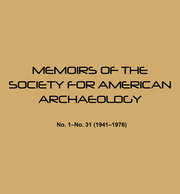Article contents
I. The Theoretical Framework
Published online by Cambridge University Press: 27 June 2018
Extract
A general outline of, and justification for, this study, as well as a discussion of the major related concepts, are presented in this chapter.
Carl Lloyd supervised an archaeological survey of the area adjacent to the Ackmen pueblo in southwestern Colorado in 1937 in order to supplement the data recovered from the excavation of this famous site. Sixty-six quarter-sections (each equivalent to a ¼ sq mi area) measuring ½ mi on each side, were intensively surveyed by a large crew. Members of the crew were stationed 100 ft apart along the ½-mi width of the quarter-section, and the entire crew walked across the ½-mi length of the quarter-section.
From each section consisting of 4 quarter-sections, 2 diagonal quarter-sections were selected for investigation. Lloyd assumed that 66 surveyed quarter-sections would reflect adequately, at least, on a 33-sq mi area near the rim. This assumption was based on the rather large (50%) sampling fraction that he employed. He was not certain that his survey methods would produce a contribution to the archaeology of the area and stated the uncertainty as follows: “Given a discontinous intensive archaeological survey of a region, what contributions can be made to the archaeology of that region by means of an analysis of the data thus obtained?” (Lloyd 1938:282). He did not explicitly answer that question during the course of his report. However, I believe that his answer was implicitly positive, that is, the kind of survey he performed did produce a meaningful contribution to the archaeology of the Ackmen-Lowry region.
- Type
- Research Article
- Information
- Copyright
- Copyright © Society for American Archaeology 1974
- 2
- Cited by


